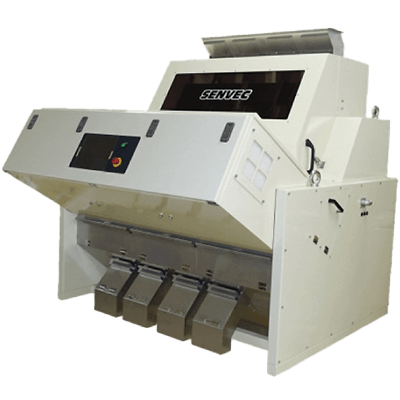What Is a Color Sorter?

A color sorter is a machine that employs technologies such as CCD cameras, near-infrared rays (NIR), and a chute with a camera to effectively sort and separate harvested crops into categories, including good quality, damaged, and foreign materials.
Harvested crops often contain not only desirable, high-quality produce but also defective items that may be discolored due to various factors, as well as foreign objects like stones and glass fragments.
Given the large volume of crop grains, manual sorting and removal of these defective and foreign items are impractical tasks.
Color sorters use CCD cameras to detect and identify defective products and foreign matter, which are then separated and removed using mechanisms like air jet nozzles.
Color sorters offer a range of features to assist in the sorting process, making them an indispensable tool for various applications, including agriculture and food processing.
Uses of Color Sorters
The primary application of color sorters is in the sorting of rice.
Harvested brown rice often contains a mixture of high-quality rice, damaged grains, and foreign materials.
Defective rice may include moldy grains, while foreign objects can consist of pebbles, glass fragments, and other items that are not safe for consumption and may pose health risks.
Defective products typically exhibit distinct differences in color compared to good quality grains. Color sorters utilize CCD cameras to detect these variations in color and then employ ejectors, such as air jets, to remove the defective grains from the stream of rice.
Some foreign materials, such as glass fragments, may closely resemble good quality grains in color. To address this, some color sorters are equipped with NIR cameras that utilize near-infrared light to distinguish between good quality grains and glass fragments, allowing for the removal of glass fragments as well.
In addition to rice, color sorters are also used for sorting other grains like wheat, barley, soybeans, and more.
Principles of Color Sorters
The fundamental principle underlying color sorters is the differentiation of crops based on their color characteristics.
When we refer to “color” in this context, it encompasses not only visible colors but also infrared “color” information that lies beyond the spectrum visible to the human eye.
Objects exhibit variations in the ratio of electromagnetic waves (light in the case of visible light) that are either reflected or transmitted (spectral reflectance/spectral transmittance) at different wavelengths.
Defective products exhibit distinct spectral reflectance and transmittance characteristics in the visible light spectrum, which makes them distinguishable by a standard CCD camera.
Transparent foreign objects, such as glass fragments, can be detected using an NIR camera because they display different spectral reflectance and transmittance patterns in response to near-infrared light.
The sorting process begins with raw materials being conveyed on a belt and directed to the optical section, which includes multiple LED light sources, two CCD cameras, and an NIR camera.
By illuminating the materials with LED light sources and analyzing them using CCD and NIR cameras, it becomes possible to identify variations in spectral reflectance and transmittance among good quality, defective, and foreign materials.
Simultaneously, the ejector section, linked to the cameras, expels air to sort the materials, separating good quality produce from defective products and foreign matter.